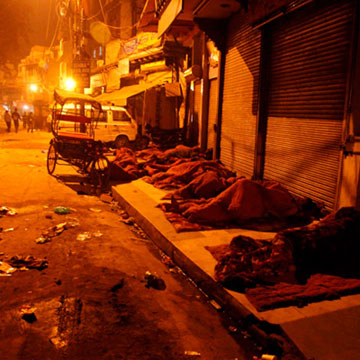 New Delhi:
New Delhi: Theyre here, there and everywhere and could well be dubbed a tribe even the gods have forgotten.
They are the legions of Delhi's homeless, living in abject filth on roads and pavements, cooking in the open and sleeping under flyovers and overbridges.
They live in constant fear of their lives from the ever-zooming traffic -- sometimes with tragic results, as happened late last month, when Lakshmi, a three-year-old, was killed when a school bus mowed her down as she ran on to the road chasing a ball.
About a dozen such homeless children aged between two and eight years live under the busy Nehru Place flyover here, and can be seen spending their days playing with sand, garbage and plastic - just feet away from where Lakshmi was killed.
Rani is piling up sand and stones at the corner of the pavement -- which is her home.
"I am making a house for myself and my family," Rani said laughingly. She is the third child of her parents and has two brothers. Originally from Rae Bareli in Uttar Pradesh, her father, Prasad Kumar, says he had shifted to Delhi before he got married.
"Obviously in search of a better livelihood. But I couldn't even provide my children a house."
Rani, barely clad enough to protect herself from the bone-chilling cold, does not go to school -- like her siblings. The family, which has been living under the flyover all these years, sells balloons at traffic signals for survival.
"I do not want to sell those balloons. I love them but my father insists upon selling those after we fill the air in them," Rani tells this correspondent, holding a heart-shaped red balloon close to her.
Prasad Kumar speaks of his fears. "We have nowhere to go. We fear for our lives every time we sleep. Even when we are not sleeping, we fear vehicles driving over us like what happened with that little girl (Lakshmi)."
Lakshmi, who was the poster child for a human rights organisation, lived under the Nehru Place flyover. She was crushed under the wheels of a school bus on January 22, a day before the National Girl Child Day.
Rani's family lives along with half a dozen other families whom they call their "neighbours". "We hardly have anyone to rely upon for our shelter. It feels like god has chosen us to be like this, live like this," said Prasad.
The national capital is home to thousands of homeless people who spend their days and nights like Rani's family.
In Sarai Kale Khan, a pregnant woman, clad in a worn-out saree, lives on the payment along with two other children, and voices other concerns. There is "no privacy for any women here", she said.
"All the women here, like me, face shameful difficulties. But we cannot do anything about it."
At the busy traffic signal near the Indian Institute of Technology, in south Delhi's Hauz Khas area, five-year-old Raju is selling red roses to commuters. But he has a target for the day. "I sell only 20 flowers a day which earns me Rs 100. I use that money to eat my favourite food like chowmein and aloo tikki (cutlet)," Raju told IANS.
"I want to study, but my father does not earn much. And I live on the road, how can I study?" he asks.
The Delhi Urban Shelter Improvement Board (DUSIB), which functions under the Urban Development Ministry of the Delhi government, is the main body responsible for maintaining shelters for the homeless.
So far, the DUSIB has constructed about 81 buildings for the homeless.
Sunil Kumar Aledia, Executive Director of the Centre for Holistic Development, said the condition for women, children and elderly among all the homeless people is more vulnerable. "What the government is doing is not sufficient. Makeshift tents during winters is not stopping the deaths. More than 3,000 homeless died in 2016 alone," Aledia said.
However, Aledia said the DUSIB alone would not be able to provide shelter and that other government departments including food, sanitation and electricity "also have to be in convergence".
He said that most of the deaths happen during the summer - "when the government does not pay attention to these people".
"There are over 16,000 people living like this in the capital as per 2014 government data. And the number of deaths is only increasing by the day. This means that what we are doing is not enough," Aledia said.
Asked why the homeless are not shifted to shelters, a Delhi Commission for Women official said: "These people have become habituated to living on roads. Even when we try to shift them to the shelters, they refuse to do so."
"We have even distributed many essential items like blankets. But when we go and look again, the condition would be the same," he added, declining to be named.
 New Delhi: Theyre here, there and everywhere and could well be dubbed a tribe even the gods have forgotten.
New Delhi: Theyre here, there and everywhere and could well be dubbed a tribe even the gods have forgotten.